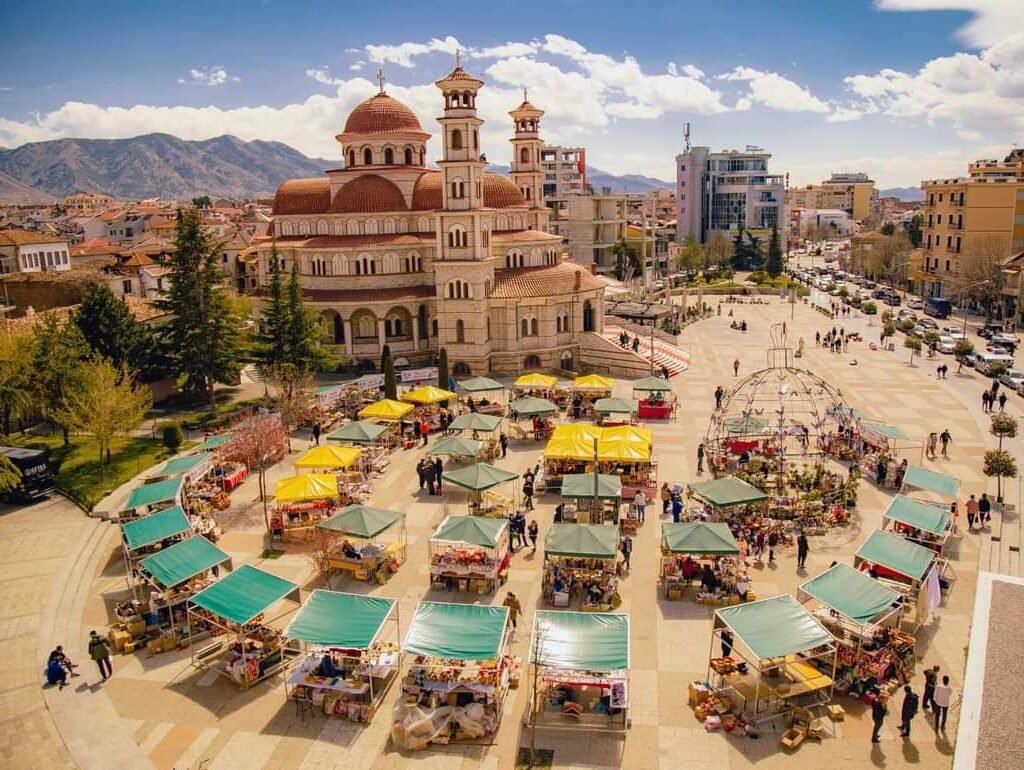

Korçë (pronounced [ˈkɔɾtʃə]; Albanian definite form: Korça) is the eighth most populous city of the Republic of Albania and the seat of Korçë County and Korçë Municipality. The total population is 75,994 (2011 census),[2] in a total area of 806 km2 (311 sq mi).[3] It stands on a plateau some 850 m (2,789 ft) above sea level, surrounded by the Morava Mountains.
The area of the Old Bazaar, including Mirahori Mosque, is considered as the urban core of the city. Founded by the local Ottoman Albanian nobleman Ilias Bey Mirahori, the urban area of Korçë dates back to the late 15th century and the beginning of the 16th century, however its actual physiognomy was realized in the 19th century, during a period that corresponds with the rapid growth and development of the city. The Old Bazaar has played a dominant role in Albania’s market history.[4] Korçë is the largest city of eastern Albania and an important cultural and industrial centre.[5]
Korçë’s foundation is closely related with the actions of Ilias Bey Mirahori, a Muslim Albanian convert born in the village of Panarit in the Korçë area, who acquired large properties in the location of present-day Korçë.[9] Ilias Bey was the ‘Master of the Stables’ of Sultan Bayezid II, and the first equerry and conqueror of Psamathia in the Ottoman capture of Constantinople.[5][10] In 1484 Ilias Bey received, as a reward from the Sultan, seven villages located in the Korçë area: Leshnja, Vithkuq, Peshkëpi, Boboshtica, Panariti, Treska, and Trebicka. This accord was finalized gradually through four firmans. In the first firman Leshja and Vithkuq were accorded to Ilias Bey as mülk (land tenure). However he met difficulties while collecting the incomes and after twelve years these villages turned into their earlier status of timars, being substituted through a second firman in the year 1497 by the locality Piskopiye, which included two sections. In the third firman (1497) the boundaries of Piskopiye were defined, establishing its demarcation between Mborje, Barç and Bulgarec, a site area corresponding to the territory of today’s Korçë city.[10][5][11] As a product of this process, the town of Korçë dates from the end of the 15th century.
The name Gorica corresponded to an older fortified settlement, and was later attached to Piskopiye, which was a separate community, and as suggested by its name, a bishop’s residence. Ilias Bey founded his works of charity in Piskopiye, building a mosque, an imaret and a muallim-hane and a hammam.[5][12] Built between 1484 and 1495, the mosque, named after him, represents one of the most important examples of Islamic architecture of Albania and its second oldest mosque after the Sultan’s Mosque of Berat.[8][5] The name Episkopi in Greek signifies a sacred place for the Orthodox faith, however, it is not certain if it was a coincidence or an intended strategy to build a mosque on the site of an older Orthodox church or monastery.[12] With the establishment of the religious, educational and charitable institutions in the area, Ilias Bey must have planned to make the village a local Islamic centre and to raise it to the rank of kasaba (“town”), through the registration of its inhabitants as citizens instead of farmers.[5] Being subjected to the Kaza of Korça, the villages of Episkopi, Boboshtica, Leshnja and Vithkuq were used in 1505 as sources of income on behalf of the five institutions of Ilias Bey’s vakfa.[13] The vakfa he founded also served the purpose of organizing the settlement of Muslim inhabitants in an area that was recently abandoned by the original Christian inhabitants.[12]
The new town must have been dominated initially by the old castle of Mborje. Throughout the 15th century and the beginning of the 16th century the castle was maintained by the Ottomans. The Tapu Defter of 1519 records a cemaat of Christian müsellems in the castle. According to this document the village of Mborje (Emboryo), which depended on Korçë (Görice), numbered 88 households of Christians and 18 households of Muslims.[5]
Korça was divided into two great neighborhoods: Varosh and Kasaba. In the 16th century Muslims constituted the 21% of the population of the town and inhabited Kasaba, which was subdivided into the smaller neighborhoods of Çarshi, Ratak, Qoshk and Dere, including the institutions established by Ilias Bey. The Christian population inhabited Varosh, which was subdivided in Varosh i Sipërm (Upper Varosh) and Varosh i Poshtëm (Lower Varosh). Varosh i Sipërm was further subdivided into the smaller neighborhoods of Mano, Barç, Jeni-Mahallë, Qiro, Penço, Manço, Manto and Kala, while Varosh i Poshtëm consisted only of Katavarosh, which was known also as “Lagja e Shën Mërisë”, named after the Church that was located there.[14]
Görice was incorporated as a sandjak in the Manastir Vilayet of the Ottoman Empire.[15]
